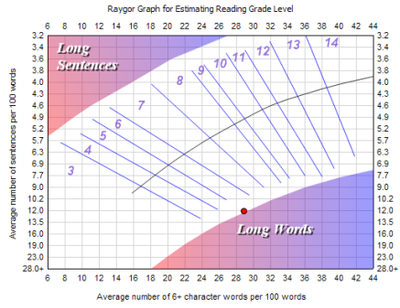This article needs additional citations for verification. (November 2024) |
The Raygor estimate graph is a readability metric for English text. It was developed by Alton L. Raygor, who published it in 1977.[1]

The US grade level is calculated by the average number of sentences and letters per hundred words. These averages are plotted onto a specific graph where the intersection of the average number of sentences and the average number of letters/word determines the reading level of the content. Note that this graph is very similar to the Fry readability formula's graph.[2]
This graph is primarily used in secondary education to help classify teaching materials and books into their appropriate reading groups.
The formula
edit- Extract a 100-word passage from the selection.[2] If the material is long, take a subsample from the beginning, middle, and end.
- Count the number of sentences in each passage. Count a half sentence as 0.5.
- Count the number of words in each passage containing six or more letters.
- Find the point on the Raygor estimate graph.
References
edit- ^ Baldwin, R. Scott; Kaufman, Rhonda K. (1979). "A Concurrent Validity Study of the Raygor Readability Estimate". Journal of Reading. 23 (2): 148–153. ISSN 0022-4103.
- ^ a b Wolinski, John T.; Bozman, Maurice W. (1983). "Using the Raygor Readability Estimate for Social Studies". Social Studies. 74 (5): 215–19.